
Édouard Manet was a French modernist painter. He was one of the first 19th-century artists to paint modern life, as well as a pivotal figure in the transition from Realism to Impressionism.

Mary Stevenson Cassatt was an American painter and printmaker. She was born in Allegheny, Pennsylvania, and lived much of her adult life in France, where she befriended Edgar Degas and exhibited with the Impressionists. Cassatt often created images of the social and private lives of women, with particular emphasis on the intimate bonds between mothers and children.

Edgar Degas was a French Impressionist artist famous for his pastel drawings and oil paintings.
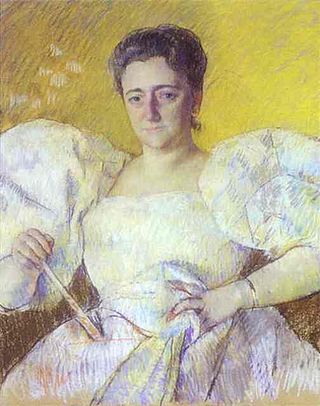
Louisine Waldron Elder Havemeyer was an art collector, feminist, and philanthropist. In addition to being a patron of impressionist art, she was one of the more prominent contributors to the suffrage movement in the United States. The impressionist painter Edgar Degas and feminist Alice Paul were among the renowned recipients of this benefactor's support.

Paul Durand-Ruel was a French art dealer associated with the Impressionists and the Barbizon School. Being the first to support artists such as Claude Monet, Camille Pissarro, and Pierre-Auguste Renoir, he is known for his innovations in modernizing art markets, and is generally considered to be the most important art dealer of the 19th century. An ambitious entrepreneur, Durand-Ruel cultivated international interest in French artists by establishing art galleries and exhibitions in London, New York, Berlin, Brussels, among other places. Additionally, he played a role in the decentralization of art markets in France, which prior to the mid-19th century was monopolized by the Salon system.

The Child's Bath is an 1893 oil painting by American artist Mary Cassatt. The painting continues her interest in depicting bathing and motherhood, but it is distinct in its angle of vision. Both the subject matter and the overhead perspective were inspired by Japanese Woodcut prints and Edgar Degas.
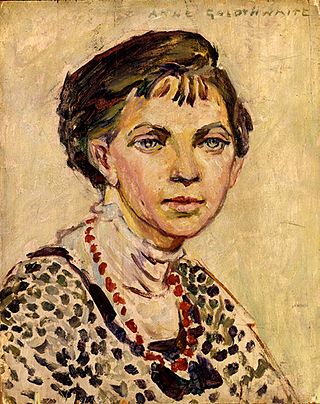
Anne Goldthwaite was an American painter and printmaker and an advocate of women's rights and equal rights. Goldthwaite studied art in New York City. She then moved to Paris where she studied modern art, including Fauvism and Cubism, and became a member of a circle that included Gertrude Stein, Henri Matisse, and Pablo Picasso. She was a member of a group of artists that called themselves Académie Moderne and held annual exhibitions.
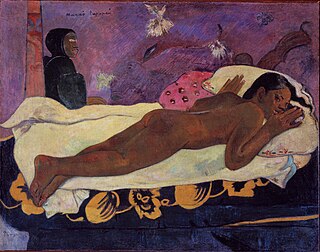
Spirit of the Dead Watching (Manao tupapau) is an 1892 oil on burlap canvas painting by Paul Gauguin, depicting a nude Tahitian girl lying on her stomach. An old woman is seated behind her. Gauguin said the title may refer to either the girl imagining the ghost, or the ghost imagining her.
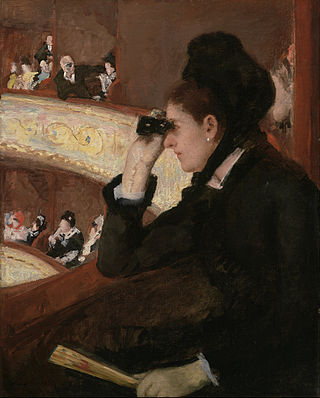
In The Loge, also known as At The Opera, is an 1878 Impressionist painting by the American artist Mary Cassatt. The oil-on-canvas painting is currently in the Museum of Fine Arts, Boston, which also holds a preliminary drawing for the work. The painting displays a bourgeois woman at the opera house looking through her opera glasses, while a man in the background looks at her. The woman's costume and fan make clear her upper class status. Art historians see the painting as commentary on the role of gender, looking, and power in the social spaces of the nineteenth century.

Little Girl in a Blue Armchair is an 1878 oil painting by the American painter, printmaker, pastelist, and connoisseur Mary Cassatt. It is in the collection of the National Gallery of Art, Washington D.C. Edgar Degas made some changes in the painting.

Gardner (Cassatt) Held by His Mother is a drypoint print dated circa 1889 by the American painter, printmaker, pastelist, and connoisseur Mary Cassatt. The example illustrated is in the collection of the Cooper-Hewitt Museum and is a gift of Samuel Putnam Avery.
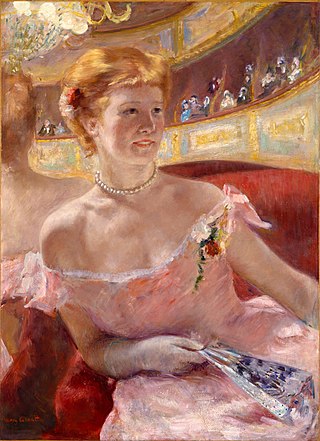
Woman with a Pearl Necklace in a Loge is an 1879 painting by American artist Mary Cassatt. The Philadelphia Museum of Art acquired the painting in 1978 from the bequest of Charlotte Dorrance Wright. The style in which it was painted and the depiction of shifting light and color was influenced by Impressionism. This painting shows a view of the modern woman and is similar in style to Degas.

Young Mother Sewing aka Little Girl Leaning on her Mother's Knee is a 1900 painting by the American artist Mary Cassatt. It is in the collection of the Metropolitan Museum of Art.

Mother and Child (The Oval Mirror) is an oil-on-canvas painting by the American Impressionist artist Mary Cassatt. The painting depicts a mother and her child in front of a mirror. The painting provides a glimpse of the domestic life of a mother and her child, evoking religious iconography from the Italian Renaissance. However, portrayals of a mother and her child are common in Cassatt's work, so it is possible that this similarity is coincidental rather than intentional.

Lydia Crocheting in the Garden at Marly is an oil-on-canvas painting by Mary Cassatt created in 1880. It is in the collection of the Metropolitan Museum of Art.
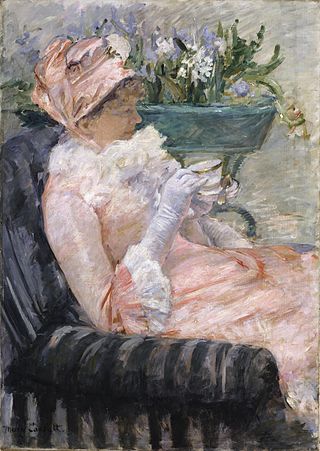
The American artist Mary Cassatt painted The Cup of Tea in Paris ca. 1879–1881. The painting depicts Mary's sister Lydia Cassatt in a typical, upper class-Parisian ritual of afternoon tea. Scholars have observed that Cassatt's choice to employ vivid colors, loose brushstrokes, and unique perspective to portray the scene makes it a quintessentially Impressionist painting.

Laure was an art model in France known for her work with artist Édouard Manet. She is best known for posing as the black maid offering the white nude figure a bouquet of flowers in Manet's 1863 painting Olympia.

La Japonaise is an 1876 oil painting by the French Impressionist painter Claude Monet. Painted on a 231.8 cm × 142.3 cm canvas, the full-length portrait depicts a European woman in a red uchikake kimono standing in front of a wall decorated by Japanese fans. Monet's first wife Camille Doncieux modeled for the painting.

The Tea, also referred to as Five O’Clock Tea, is an oil-on-canvas painting of two women having tea by the American Impressionist painter Mary Cassatt. The role of gender in the painting has been the subject of differing interpretations among art historians. Griselda Pollock describes the confined interior as an evocation of the spatial and social constraints placed on women at the time. Norma Broude asks whether the work might contain "possibilities for empowerment," showing the agency that women exercised through sociability. And John Loughery argues that the intention behind Cassatt's work might always remain a mystery.

A Woman and a Girl Driving is an oil-on-canvas painting by American Impressionist Mary Cassatt, painted in 1881. It emphasizes the theme of female autonomy in a male dominated society. Lydia Cassatt, the artist's sister, is shown holding the reins of the family's carriage alongside Odile Fèvre, the niece of Edgar Degas, and a servant to the family, Mathieu, traveling through the Bois de Boulogne in Paris. Emphasizing Lydia's position of command, Cassatt draws attention to the evolving perceptions of female identity in the late 19th century. The painting serves to challenge prevailing social norms of the time and unveil the range of female experience.






















